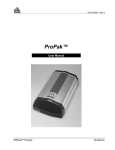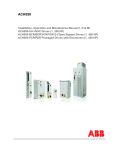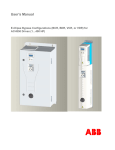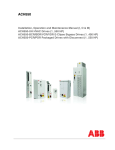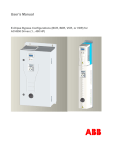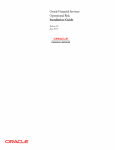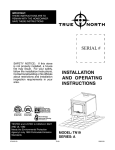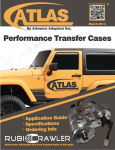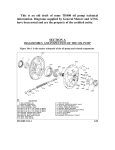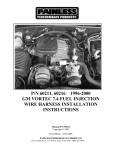Download SECTION A
Transcript
SECTION A DISASSEMBLY, INSPECTION, AND OVERHAUL OF THE CENTER SUPPORT Figure 13A-1 is the master schematic of the center support assembly with the cast aluminum intermediate clutch piston. Figure 13A-2 is the master schematic of the center support assembly with the stamped steel intermediate clutch piston. FIGURE 13A-1 FIGURE 13A-2 GM AMC/JEEP Press down on the intermediate clutch spring retainer (647) and remove the snap ring (646) that fastens it to the center support. See Figure 13A-3. Lift off the retainer. See Figure 13A-4. FIGURE 13A-3 FIGURE 13A-4 GM Remove the three intermediate clutch release springs (648) from the cast aluminum intermediate clutch piston (650). See Figure 13A-5. Note that all 1964 and 1965 models, as well as all 1966 to 1972 Cadillacs were fitted with 12 intermediate clutch release springs. Inspect the release springs for cracks, fatigue, and distortion. Shiny wear visible on the spring outside diameter is considered normal. With models that use the stamped steel intermediate clutch piston, remove the three intermediate clutch release springs followed by the plastic intermediate clutch spring guide (649). See Figure 13A-6. FIGURE 13A-5 GM FIGURE 13A-6 GM Remove the intermediate clutch piston (650) from the center support (654). Removal of the cast aluminum piston is shown in Figure 13A-7. Removal of the stamped steel piston is shown in Figure 13A-8. FIGURE 13A-7 GM FIGURE 13A-8 GM As noted, the intermediate clutch piston may be either cast aluminum or stamped steel. The cast aluminum piston is shown in Figure 13A-9. The stamped steel piston is shown in Figure 13A-10. FIGURE 13A-9 FIGURE 13A-10 Remove the outer (652) and inner (651) lip seals from the intermediate clutch piston. See Figures 13A-11 and 13A-12. Examine the seals and become familiar with how they fit the piston and seal in the support. Do not discard the seals. You will use them to identify the replacement seals later on during assembly. Inspect the piston for cracks. Inspect the piston seal grooves for nicks or damage. FIGURE 13A-11 GM FIGURE 13A-12 GM Remove and discard the four oil seal rings (653) from their ring grooves in the center support. See Figure 13A-13. 1964 to 1974 models were assembled with cast iron hook type oil seal rings. 1975 and up models received scarf cut Teflon type oil seal rings. See Figure 13A-14. FIGURE 13A-13 GM FIGURE 13A-14 GM Inspect the seal ring grooves for signs of wear or damage. See Figure 13A-15. If any of the seal rings are stuck or sticking in their grooves, check the seal ring grooves for signs of damage resulting from contact with the direct clutch housing. When the direct clutch housing operates with excessive radial runout, the seal ring bore on the inside diameter of the housing comes in contact with the outside diameter of the seal ring grooves. This results in the peening over or closing of the seal ring groove openings. Inspect and replace the center support if necessary. When using cast iron, solid Teflon, or Peak oil seal rings, test fit the rings in their respective grooves. Insert the outside diameter of the ring into the ring groove and rotate it around the full diameter of the groove. See Figure 13A-16. The ring should rotate smoothly around the groove. If the ring fails to rotate smoothly, inspect the groove for nicks or burrs. Remove any imperfections with a small file and recheck. Seal ring groove width should measure @ approximately .095”. Ring groove depth should measure @ approximately .090”. FIGURE 13A-15 FIGURE 13A-16 Verify the presence of the bleed orifice cup plug installed in the intermediate clutch piston cavity. See Figure 13A-17. Verify the bleed orifice in the cup plug is free of obstruction and/or debris. Note that all 1964 and 1965 models, as well as all 1966 to 1972 Cadillacs were fitted with center supports void of the orifice cup plug. FIGURE 13A-17 GM The reaction carrier bushing journal is an integral part of the center support. See Figure 13A-18. Inspect the bushing journal for any signs of abnormal wear. Use your fingernail to check for scoring or grooving of the journal. Minor scoring can sometimes be removed with a fine grit emery cloth. Lubrication for the reaction carrier bushing is supplied thru a hole in the bushing journal. Verify the oil hole in the bushing journal is free of obstruction and/or debris. See Figure 13A-19. Prepare the journal by gently polishing it with a fine scotch pad. FIGURE 13A-18 FIGURE 13A-19 Measure the bushing journal with a micrometer. See Figure 13A-20. The specification for the bushing journal diameter is 2.187” to 2.1875”. The low roller clutch inner race is an integral part of the center support. See Figure 13A-21. Inspect the race for any signs of abnormal wear or damage. Use you fingernail to check for scoring or grooving of the race. FIGURE 13A-20 FIGURE 13A-21 The inner race is pinned and bolted to the center support. See Figure 13A-22. DO NOT remove the bolts. Inspect the threads that receive the center support to case bolt for signs of damage or stripping. See Figure 13A-23. FIGURE 13A-22 FIGURE 13A-23 Inspect the center support bushing for signs of wear, scoring, grooving, pitting or flaking. Check the center support bushing to sun gear shaft clearance. Install the sun gear shaft (664) into the center support. Install the largest feeler gage that just fits in between the bushing and the shaft to obtain the clearance. See Figure 13A-24. The specification for the clearance is .0015” to .005”. If there is excessive clearance, the bushing should be replaced. The replacement center support bushing is shown in Figure 13A-25. Before removing the bushing, note the orientation between the center support bushing oil slot and the center support oil hole. See Figure 13A-26. When installed, the bushing oil slot and the center support oil hole must be in alignment. If not, lube oil to the intermediate sprag and intermediate clutch pack will be reduced or completely cut off resulting in transmission failure. Using a press and bushing driver, remove the center support bushing from the center support. See Figure 13A-27. Always remove the bushing starting at the rear end of the support, “pushing” the bushing out the front end of the support. FIGURE 13A-24 FIGURE 13A-26 FIGURE 13A-25 AMC/JEEP FIGURE 13A-27 GM Note that this bushing does not like to be installed with a hammer and bushing driver. Align the bushing oil slot with the center support oil hole, and using an arbor press install the bushing into the support. See Figure 13A-28. Install the bushing flush with the top of its bore. Once again verify that the bushing oil slot and the center support oil hole are in alignment. Flush the center support out with clean solvent and blow dry with compressed air to remove any material generated during bushing installation. To verify the bushing has been installed properly, lube the bushing and install the sun gear shaft into the support and verify smooth rotation. See Figure 13A-29. FIGURE 13A-28 FIGURE 13A-29 Air check the center support oil passages to verify they are not interconnected. See Figure 13A-30. FIGURE 13A-30 GM Use Figure 13A-31 as a guide to reassemble the center support and related components. FIGURE 13A-31 GM Install the inner (651) and outer (652) intermediate clutch piston lip seals onto the intermediate clutch piston (650). See Figures 13A-32 and 13A-33.The lip of the seals will point towards the rear of the piston. FIGURE 13A-32 GM FIGURE 13A-33 GM Before attempting installation of the piston, take note of how the protruding spring pockets at the rear of the intermediate clutch piston fit into the spring pocket cavities in the front face of the center support. See Figures 13A-34 and 13A-35. FIGURE 13A-34 FIGURE 13A-35 Lubricate the lip seals and install the intermediate clutch piston down over the oil seal ring boss of the center support. Install a .008” to .010” feeler gage between the inner lip seal and the inner lip seal boss to guide the piston into the support. Without cocking the piston, apply a slight downward pressure with one hand, while rotating the feeler gage around the inner diameter of the piston. See Figure 13A-36. As the piston begins to enter its cavity in the support, it will drop down about .100” over the inner lip seal boss. Next, work your way around the outside diameter of the outer lip seal with the smooth, rounded 90 degree corner of your pick tool to gently guide the seal into its cavity. Do this while applying a slight downward pressure until the piston is fully seated. See Figure 13A-37. When fully seated, the rear ledge of the piston face will bank against the front face of the center support. FIGURE 13A-36 FIGURE 13A-37 Figures 13A-38 and 13A-39 show two versions of the service manual method and tooling for installing the piston. This tool is not necessary for the seasoned professional, but may be helpful to the production or novice builder. FIGURE 13A-38 AMC/JEEP FIGURE 13A-39 GM Install the three intermediate clutch release springs (648) into the cast aluminum intermediate clutch piston (650). Be sure to install the springs evenly spaced. See Figure 13A-40. With all 1964 and 1965 models, and all 1966 to 1972 Cadillacs install 12 intermediate clutch release springs. With models that use the stamped steel intermediate clutch piston, install the plastic intermediate clutch spring guide (649) into its cavity in the piston, followed by the three intermediate clutch release springs. See Figures 13A-41 and 13A-42. Install the intermediate clutch spring retainer (647)) on top of the springs. See Figure 13A-43. FIGURE 13A-40 GM FIGURE 13A-41 AMC/JEEP FIGURE 13A- 42 AMC/JEEP FIGURE 13A-43 AMC/JEEP Compress the retainer and install the snap ring (646). See Figure 13A-44. Figure 13A-45 shows the service manual method and tooling for the job. When working with pistons that use three release springs, the retainer may be compressed by hand. Verify the clutch release springs are not leaning. If necessary, straighten them with a small screwdriver. Air check the clutch piston for proper operation by applying 20 to 25 PSI of compressed air to the intermediate clutch passage in the center support. See Figure 13A-46. Note that using excessive pressure during the air check can blow the piston and seals out of the bore and can result in parts damage or personal injury. Applying air pressure should result in the piston pumping up against release spring pressure. Releasing air pressure should result in the piston retracting against release spring pressure. Most center supports will have the bleed orifice cup plug in the rear. See Figure 13A-47. A small amount of air is expected to escape out of the bleed orifice, but there should be no leakage from the lip seals. If the piston fails to pump up or release, disassemble the components and check for the problem before continuing. A final check with full pressure will be performed during the final assembly of the transmission. Install the thrust washer (656) into its recess in the rear of the center support. Retain the washer with assembly lube. See Figure 13A47. FIGURE 13A-44 FIGURE 13A-45 FIGURE 13A-46 GM FIGURE 13A-47 GM GM Install four oil seal rings (653) into the ring grooves in the center support. See Figure. Note that with applications which dual feed the direct clutch housing, the omission of the second oil seal ring from the top of the seal ring boss is required. If the dual feed methods in this publication are being implemented, the omission of the seal ring is required. Note that the use of cast iron seal rings is not recommended in any TH400 with fixed line pressure or line pressure values greater than stock. Rapid seal ring, ring groove and direct clutch housing bore wear will most certainly result. Teflon or Peak oil seal rings are preferred. Proper orientation of cast iron hook type seal rings is shown in Figure. FIGURE GM FIGURE Proper orientation of Teflon scarf cut seal rings is shown in Figure. Properly installed Peak seal rings are shown in Figure. FIGURE GM FIGURE Solid Teflon sealing rings were fitted to the center support of early model 4L80E transmissions. See Figure. These rings will retro-fit the TH400 center support but require the use of specialized installation tools or some ingenuity on the part of the installer. A sleeve is fit over the sealing ring boss, and its height adjusted so that its leading edge is just above the seal ring groove the ring will be installed in. The sealing ring is then placed over the conical end of the sleeve, and a second tool is used to push the ring down over the sleeve, stretching the inside diameter just enough so that it can enter the ring groove. See Figure. FIGURE FIGURE A sizing tool is then fit down over the rings and rotated, sizing the rings to the proper dimension. See Figure. A completed solid seal ring retro-fit is shown in Figure. Note the omission of the second oil seal ring, indicating the direct clutch housing is being dual fed. FIGURE FIGURE SECTION B IDENTIFICATION AND INTERCHANGE OF THE CENTER SUPPORT AND RELATED COMPONENTS Identify the type of center support in use. There are first design and second design supports. There are early and late versions of the first design. Most early and late first design supports share the same casting number, 8623138. The early first design support was used in all 1964 to mid-year 1969 models, and can be identified by measuring the width of the center support to case lugs. See Figure 13B-1. The lug width will measure in @ approximately .370”, and it does not install into the transmission case with the center support to case anti fretting ring (657). See Figure 13B-2. The late first design support was used in all late 1969 to early 1990 models, and can be identified by measuring the width of the center support to case lugs. The lug width will measure in @ approximately 330”, and the support installs into the transmission case in conjunction with the anti fretting ring. To accommodate the ring, the lug width was reduced the same amount as the ring width. The purpose of the ring is to insulate the support ledge in the transmission case from center support rearward thrust and radial movement that results in case damage. Without the ring, the support lugs tend to eat or fret the transmission case at the lug to ledge interface. Because early models do not have the ring, increased case wear results in this area. It is always recommended to update to the anti fretting ring/late first design center support combination on models not originally equipt with these components. The early first design support may be used with the anti fretting ring by machining .040” from the rear face of the case lugs. If you try to install the anti fretting ring with the early first design center support, you will not be able to properly install the center support bolt (79) or the beveled snap ring (645). FIGURE 13B-1 FIGURE 13B-2 GM Note that all 1964 and 1965 models, as well as all 1966 to 1972 Cadillacs were fitted with a center support assembly void of a bleed orifice cup plug in the intermediate clutch piston cavity. See Figure. Note that these models also used twelve intermediate clutch release springs (648) instead of the usual three installed in all other models. Unlike later models, these supports are void of center support to case lugs in the casting at the area shown in Figure. Although the lugs are present on later model supports, the case has always been void of “receiver grooves” in that area. This alludes to the fact that it was easier to manufacture the support with all of the lugs rather than to “time” each support during the machining process. FIGURE FIGURE Because the center support is filled from the bottom up, air tends to get trapped in the piston cavity when the circuit is exhausted or not charged with intermediate clutch oil. Without a bleed orifice, this trapped air acts as a variable accumulator in the circuit. This prevents maximum apply pressure from being reached during 1-2 upshifts, reducing intermediate clutch capacity, resulting in intermediate clutch slippage. For all 1966 models, with the exception of Cadillac, who followed suit for their 1973 models, a .020” bleed orifice cup plug was installed in the intermediate clutch piston cavity. See Figure. The purpose of the bleed orifice cup plug is to purge trapped air from the intermediate clutch piston cavity during intermediate clutch application. Due to the tendency of the support void of the orifice cup plug to reduce clutch capacity and shift quality, its usage in any heavy duty or performance application is not recommended. INFORMATION IN NEXT SECTION HAS BEEN EXTENSIVELY UPDATED. THE EXACT REASON FOR THE BOLT CHANGE AND 2 LUGS HAS BEEN UNCOVERED. All TH400 transmissions produced after March 1, 1990 received a revised center support casting. This is known as the second design center support. The casting number for the second design center support is 8678032. This is the same support used in all production 1991 to 1995 GM 4L80E transmissions. This support uses the anti fretting ring and the width of the lugs measures approximately .330”. The 8678032 casting has slight differences in non critical dimensions when compared to the 8623138 casting, however; they do not affect fit or function. The second design support also received a different center support to case bolt. This bolt is longer than the previous design and must be used with second design supports only. See Figure 13B-3. When used with the anti fretting ring and proper center support to case bolt, the second design center support is fully interchangeable with both the early and late first design center supports. FIGURE 13B-3 GM Beginning on December 21, 1993 some TH400 GM Goodwrench Replacement Transmissions that used the second design support were built with a new case to center support service bolt. The bolt is coated with zinc chromate and is yellow in color. According to GM, the reaming of the threaded hole and the installation of the new bolt allowed the support to be reconditioned in the field one time before replacement. See Figure 13B-4. Apparently the engineers believed that the support was a wear item and was to be replaced during overhaul. The service bolt and instruction sheet is available under GM Part Number 24202218. FIGURE 13B-4 GM There is a unique difference found when comparing the first and second design center supports. The first design center support uses 17 full width center support to case lugs. See Figure 13B-5. The second design center support only uses two full width center support to case lugs. See Figure 13B-6. No technical information regarding the reasoning for the change has ever been made available. It is evident that the reduced lug count can allow increased radial movement between the center support to case interface under extreme loading conditions in Lo range. FIGURE 13B-5 FIGURE 13B-6 Intermediate Clutch Piston From 1964 to 1973, all TH400 transmissions were built with the cast aluminum intermediate clutch piston. See Figure 13B-7. In 1974, the stamped steel intermediate clutch piston was introduced and used on some models, while the aluminum piston was used on others. See Figure 13B-8. Use of the stamped steel piston continued until the end of the 1984 model year, at which time its use was discontinued. Note that unlike the aluminum piston, the steel piston is void of release spring pockets. To provide a means for locating the springs, the plastic intermediate clutch spring guide is used with the steel piston. Both intermediate clutch piston combinations are fully interchangeable. Steel piston usage in performance builds is not encouraged. With increased line pressure, it suffers from deflection and a narrow work surface, reducing clutch pack performance. The piston work surface is the area of the front face of the piston that contacts and pushes on the first steel in the clutch pack. See Figure 13B-9. Note the narrow work surface of the steel piston compared to the wide work surface of the aluminum type. FIGURE 13B-7 FIGURE 13B-8 FIGURE 13B-9 Installing 4L80E Intermediate Clutch Piston and or Wave Plate into the TH400 The terms “overall work surface height” (“A”), “work surface” (“B”), and “counterbore diameter” (“C”) describe piston features pertinent to identification and interchange. See Figure 13B-10. FIGURE 13B-10 There are two types of production cast aluminum intermediate clutch pistons for the 4L80E. 1991-1995 models received part number 8661657 and are known as the early pistons. 1996 and up models received part number 24202553 and are known as the late pistons. EARLY PISTON # 8661657 LATE PISTON # 24202553 Functional dimensions between the early 4L80E intermediate clutch piston and the TH400 stamped steel or cast aluminum piston are similar with one exception. As cast, the overall work surface height of the 4L80E piston measures .140”, compared to .155” with the TH400 piston. This will result in a .015” increase in intermediate clutch pack end clearance when retrofitting. This is no major cause of concern, and if necessary, clutch pack end clearance can be adjusted during final transmission assembly. All early 4L80E intermediate clutch pistons will retro-fit all TH400 transmissions. Late model 4L80E transmissions incorporate the use of a waved plate installed between the intermediate clutch piston and the first steel plate in the clutch pack as a cushioning device. See Figure 13B-11. FIGURE 13B-11 GM Clutch piston dimension revisions accommodate the waved plate. Locating tabs on the inside diameter of the wave plate permit the locating of the waved plate to the counterbore of the piston. See Figure 13B-12. The counterbore diameter was enlarged from 5.125” (common between all TH400 and early 4L80E intermediate clutch pistons), to 5.225”, providing the necessary clearance for the waved plates locating tabs. See Figure 13B-13. FIGURE FIGURE The piston overall work surface height was reduced from .140” to .090”, restoring clutch pack end clearance lost with the addition of the waved plate. This is where a potential problem can occur. Whenever installing a late 4L80E intermediate clutch piston into a TH400, the matching waved plate (684) must also be used. If not, the first steel plate in the clutch pack will not rest on the piston as intended. Instead, it will sit on top of the beveled center support to the case snap ring (645). See cut away view in Figure 13B-14. This will result in excessive intermediate clutch piston travel and possible functional problems may result. When used as a set, the late 4L80E intermediate clutch piston and matching waved plate will retro-fit all TH400 transmissions. When installing the 4L80E waved plate into a TH400 with a TH400 or early 4L80E intermediate clutch piston, the piston counterbore must be machined to the revised counterbore dimension. FIGURE 13B-14 SECTION C COMPONENT UPGRADES AND MODIFICATIONS Creating a Thrust Surface in the Front Face of the Center Support Normal operating conditions result in the forward clutch housing assembly thrusting rearward into the mainshaft (681). In high load applications this rearward thrust can push the mainshaft with enough force to result in damage to the # 22 thrust bearing assembly (686, 687, 688) and output shaft to case thrust and selective washers (695,696). By creating a thrust surface in the front face of the center support, this rearward thrust can be cancelled out at the center support without making it to the mainshaft. The origin of this rearward thrust begins in the torque converter. Pressurized converter charge oil in the torque converter creates a force that acts on the front face of the input shaft (601). The amount of this force (measured in pounds) is calculated by multiplying converter charge pressure by the surface area of the front face of the input shaft. Typically, “corrected”* converter charge pressure in a high load application will be @ 60 PSI. The surface area of a production input shaft is .785”. This combination results in 47.1 pounds of rearward force acting on the front face of the input shaft and forward clutch housing assembly. This force is then transmitted to the mainshaft at the interface between the forward clutch hub (616), and the mainshaft. This occurs because the front end of the mainshaft acts as a stop for the front end of the forward clutch hub. See Figure 13C-4. FIGURE 13C-4 * Please note that the term “corrected” used in the above paragraph is referring to a converter charge circuit that has been modified to reduce dangerously high converter charge pressures using the techniques in this manual. If left uncorrected, converter charge pressure and rearward thrust values can be as much as double that of the given example. From the mainshaft, the force is transmitted to the rear internal gear (685) and # 22 thrust bearing assembly (686,687,688), then to the output shaft (691) and on to the output shaft to case thrust and selective washers (695,696), where it is finally grounded out at the transmission case. See Figure 13C-5. In heavy duty and high load applications this can result in complete failure of the #22 thrust bearing assembly. FIGURE 13C-5 GM The solution is to remove rearward thrust from the forward clutch housing assembly to the mainshaft. This requires the creation of a thrust surface for the forward clutch housing assembly independent of the mainshaft. This is performed in two steps. 1. A thrust bearing assembly is installed between the front face of the forward clutch hub (616) and the front thrust surface of the direct clutch housing (633). This modification is shown in Section 11-B. This will divert rearward thrust being applied to the mainshaft to the direct clutch housing. This force is now transmitted to the sun gear shaft (664) at the interface between the direct clutch housing and sun gear shaft. This occurs because the front end of the sun gear shaft acts as a stop for the rear end of the direct clutch housing. See Figure 13C-6. The force is then transferred from the sun gear shaft to the sun gear (665), on to the # 21 thrust bearing assembly (682,683,684), followed by the rear internal gear (685), and returning back to the #22 thrust bearing assembly (686,687,688). See Figure 13C-7. At this point we have done nothing more than reroute the rearward thrust we are trying to eliminate, back to the #22 thrust bearing assembly whose durability we are attempting to improve. However, because we have diverted rearward thrust into the direct clutch housing, the housing can now be grounded to the center support, diverting all rearward thrust into the support. Grounding the rear of the direct clutch housing to the center support removes all rearward thrust at the interface between the housing and the front of the sun gear shaft. FIGURE 13C-6 FIGURE 13C-7 GM 2. A bearing pocket is machined at the bottom of the snap ring boss recess and fitted with a thrust bearing, permitting the grounding of the direct clutch housing to the center support. See Figure 13C-8. The pocket is machined to a depth of .375” measured from the front face of the boss and to an inside diameter of $$$ and an outside diameter of 2.875”. FIGURE 13C-8 Selective shims installed between the thrust bearing and the bearing pocket “push” the direct clutch housing off the sun gear shaft stop permitting it to thrust against the center support. Clearance adjustment is covered on page $$$. The thrust bearing and shim kit is available under CK Performance part # 400CC/TBAWSP, and a machined center support with thrust bearing and shim kit under CK Performance part # 400CC/RCSA. FIGURE 13C-9 FIGURE 13C-10





























